HNBS 301: Business and Business Environment - Sainsbury Report
VerifiedAdded on 2021/01/13
|12
|3457
|26
Report
AI Summary
This report provides a comprehensive analysis of Sainsbury's business environment, encompassing various organizational types, functions, and structures. The first part of the report overviews different types of organizations, including public, private, voluntary, and partnership businesses, and examines their growth within the international business environment. It details the background, products and services, size, scope, vision, mission, business objectives, legal structure, and stakeholders of each organization, with Sainsbury as a primary example. The report then delves into the functions within an organization, using an organizational chart to illustrate their interrelations, such as procurement, design engineering, production, and sales. The second part of the report applies PESTLE and SWOT analyses to Sainsbury, evaluating the impact of political, economic, social, technological, legal, and environmental factors. It assesses Sainsbury's strengths, weaknesses, opportunities, and threats, and analyzes how the internal and external environments influence the company's decision-making processes, concluding with key findings and recommendations.
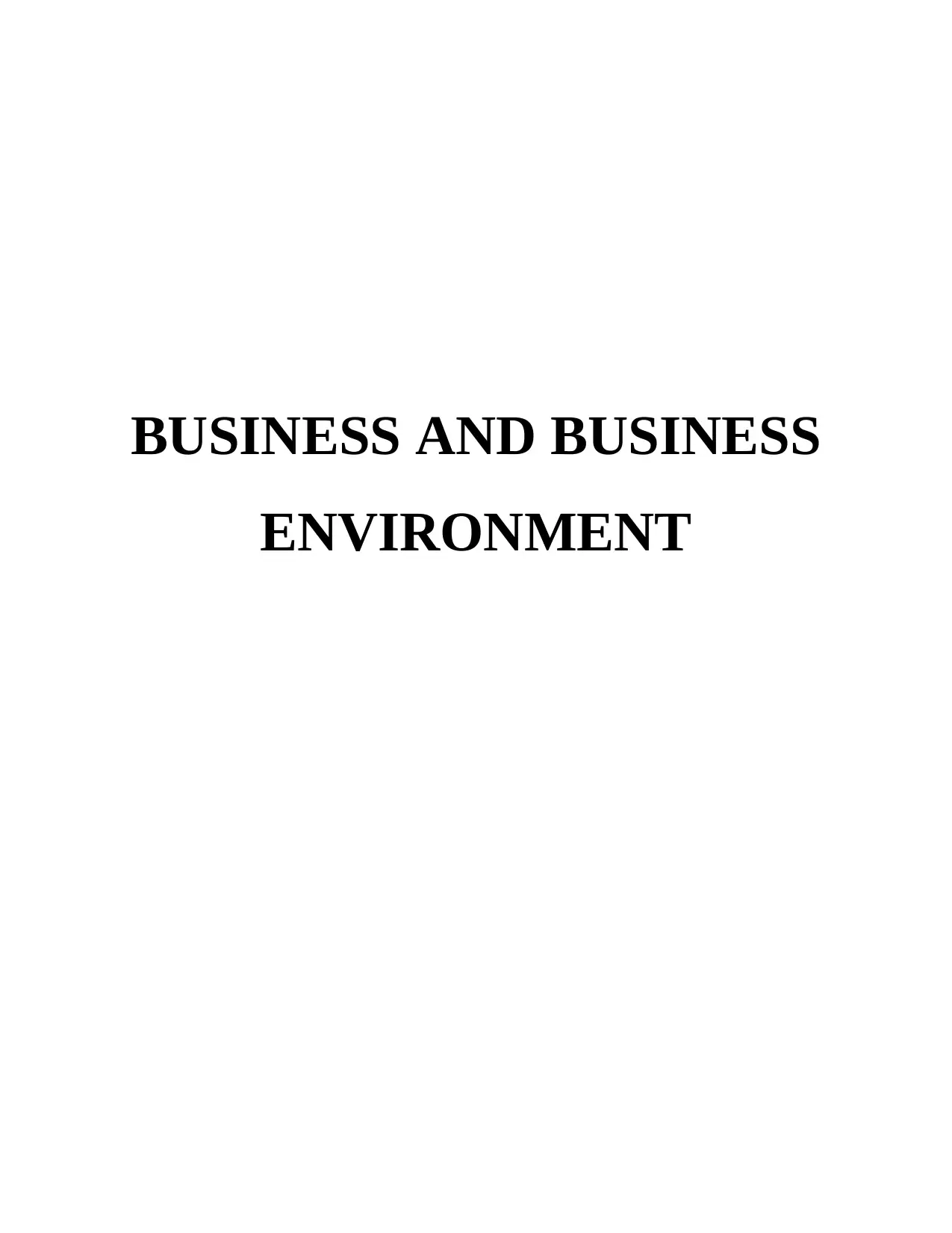
BUSINESS AND BUSINESS
ENVIRONMENT
ENVIRONMENT
Paraphrase This Document
Need a fresh take? Get an instant paraphrase of this document with our AI Paraphraser
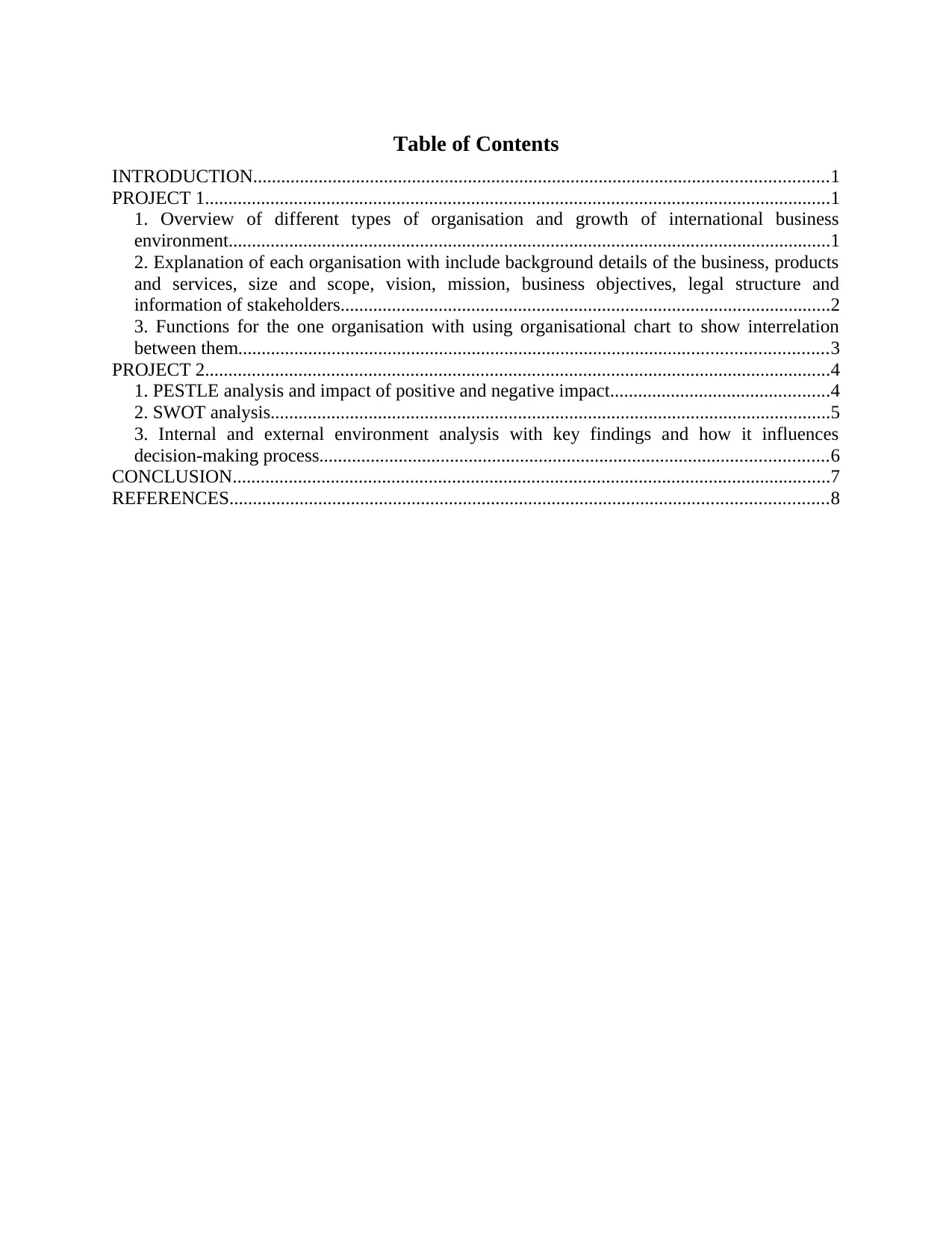
Table of Contents
INTRODUCTION...........................................................................................................................1
PROJECT 1......................................................................................................................................1
1. Overview of different types of organisation and growth of international business
environment.................................................................................................................................1
2. Explanation of each organisation with include background details of the business, products
and services, size and scope, vision, mission, business objectives, legal structure and
information of stakeholders.........................................................................................................2
3. Functions for the one organisation with using organisational chart to show interrelation
between them..............................................................................................................................3
PROJECT 2......................................................................................................................................4
1. PESTLE analysis and impact of positive and negative impact...............................................4
2. SWOT analysis........................................................................................................................5
3. Internal and external environment analysis with key findings and how it influences
decision-making process.............................................................................................................6
CONCLUSION................................................................................................................................7
REFERENCES................................................................................................................................8
INTRODUCTION...........................................................................................................................1
PROJECT 1......................................................................................................................................1
1. Overview of different types of organisation and growth of international business
environment.................................................................................................................................1
2. Explanation of each organisation with include background details of the business, products
and services, size and scope, vision, mission, business objectives, legal structure and
information of stakeholders.........................................................................................................2
3. Functions for the one organisation with using organisational chart to show interrelation
between them..............................................................................................................................3
PROJECT 2......................................................................................................................................4
1. PESTLE analysis and impact of positive and negative impact...............................................4
2. SWOT analysis........................................................................................................................5
3. Internal and external environment analysis with key findings and how it influences
decision-making process.............................................................................................................6
CONCLUSION................................................................................................................................7
REFERENCES................................................................................................................................8

⊘ This is a preview!⊘
Do you want full access?
Subscribe today to unlock all pages.

Trusted by 1+ million students worldwide

INTRODUCTION
Business environment is important aspect which contain ongoing changes in the business
to create more awareness. With this regard, opportunities also expanded within the business
economy to efficiently develop business operations (Botha, Kourie and Snyman, 2014).
In this context, present study based on Sainsbury which is retail sector business of UK
and expanded their operations in different areas of the world easily. They are providing online
delivery of different products to attract customers and gain their loyalty as well.
For gaining insight information of the present report, it covers different types of
organisation and growth to deal with international business environment. Furthermore,
background details, size and scope, etc. of different businesses also develop in international areas
to gain more profitability at workplace. Moreover, it includes impact of PESTLE and Swot
analysis on the business operations.
PROJECT 1
1. Overview of different types of organisation and growth of international business environment
In the international business environment, there are different types of businesses operate
to gain more growth and profitability at workplace. They are as follows: Public company: Public businesses determine their functions and operations that build
trust and credibility in a particular group (Hamilton and Webster, 2015). They are also
raised awareness towards the enterprise to define, control and distribute message inside
and outside the enterprise. Sainsbury is public limited company that determine products
and services in different areas of the world. Private company: In order to develop more profitability and effectiveness, private
companies focus on shareholders profits to create more profits and revenue at workplace.
In this regard, they make their growth with expansion of business and increase
profitability with value and selling them at a profit (Crane and Matten, 2016). For
instance, Asda is private sector company that deal to gain more profits and revenue in the
business. Voluntary business: Voluntary business consider their operations and functions to gain
common interest in the association of business. There are several members in a group
who enter in agreement as volunteers in a form of body to accomplish particular business.
1
Business environment is important aspect which contain ongoing changes in the business
to create more awareness. With this regard, opportunities also expanded within the business
economy to efficiently develop business operations (Botha, Kourie and Snyman, 2014).
In this context, present study based on Sainsbury which is retail sector business of UK
and expanded their operations in different areas of the world easily. They are providing online
delivery of different products to attract customers and gain their loyalty as well.
For gaining insight information of the present report, it covers different types of
organisation and growth to deal with international business environment. Furthermore,
background details, size and scope, etc. of different businesses also develop in international areas
to gain more profitability at workplace. Moreover, it includes impact of PESTLE and Swot
analysis on the business operations.
PROJECT 1
1. Overview of different types of organisation and growth of international business environment
In the international business environment, there are different types of businesses operate
to gain more growth and profitability at workplace. They are as follows: Public company: Public businesses determine their functions and operations that build
trust and credibility in a particular group (Hamilton and Webster, 2015). They are also
raised awareness towards the enterprise to define, control and distribute message inside
and outside the enterprise. Sainsbury is public limited company that determine products
and services in different areas of the world. Private company: In order to develop more profitability and effectiveness, private
companies focus on shareholders profits to create more profits and revenue at workplace.
In this regard, they make their growth with expansion of business and increase
profitability with value and selling them at a profit (Crane and Matten, 2016). For
instance, Asda is private sector company that deal to gain more profits and revenue in the
business. Voluntary business: Voluntary business consider their operations and functions to gain
common interest in the association of business. There are several members in a group
who enter in agreement as volunteers in a form of body to accomplish particular business.
1
Paraphrase This Document
Need a fresh take? Get an instant paraphrase of this document with our AI Paraphraser
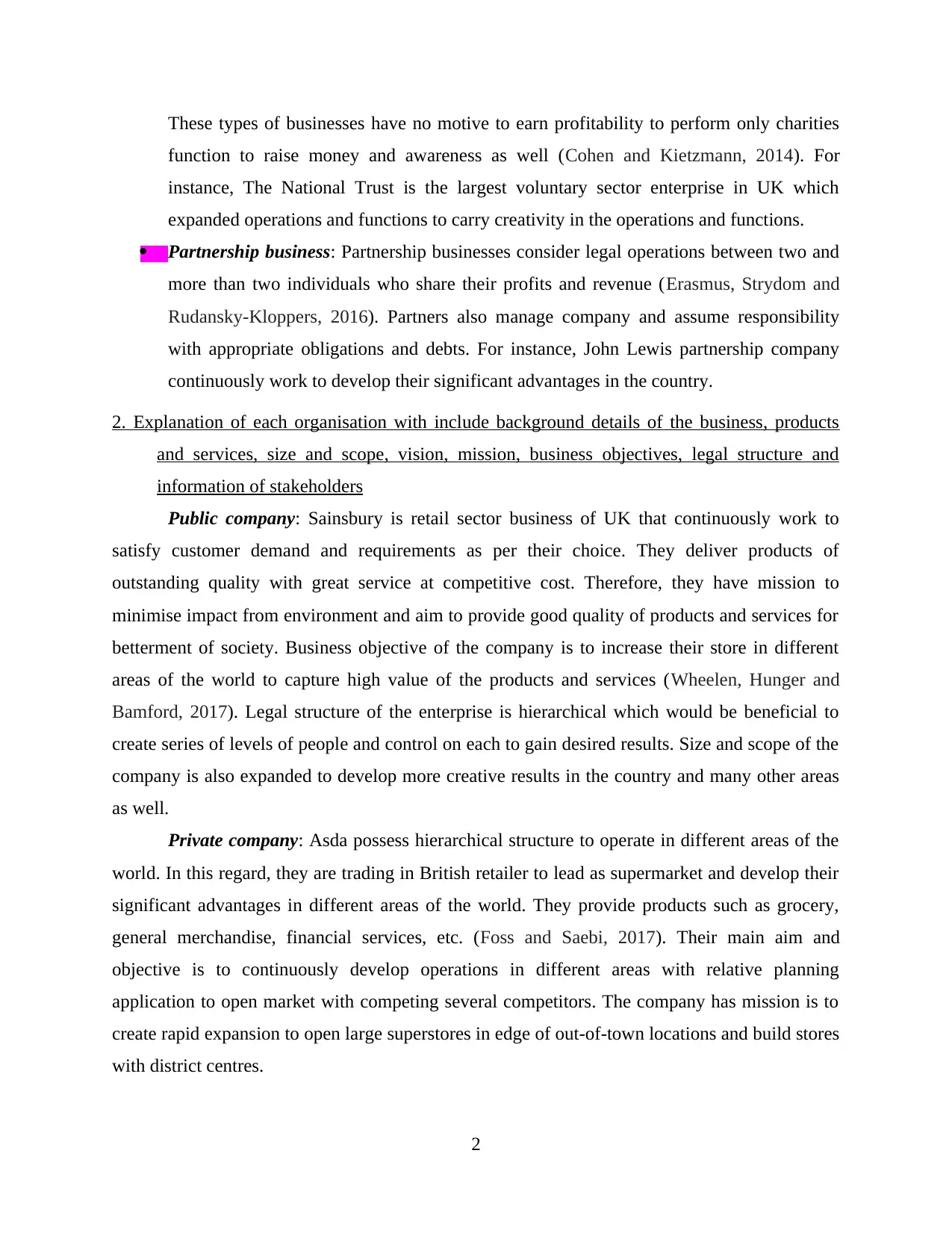
These types of businesses have no motive to earn profitability to perform only charities
function to raise money and awareness as well (Cohen and Kietzmann, 2014). For
instance, The National Trust is the largest voluntary sector enterprise in UK which
expanded operations and functions to carry creativity in the operations and functions.
Partnership business: Partnership businesses consider legal operations between two and
more than two individuals who share their profits and revenue (Erasmus, Strydom and
Rudansky-Kloppers, 2016). Partners also manage company and assume responsibility
with appropriate obligations and debts. For instance, John Lewis partnership company
continuously work to develop their significant advantages in the country.
2. Explanation of each organisation with include background details of the business, products
and services, size and scope, vision, mission, business objectives, legal structure and
information of stakeholders
Public company: Sainsbury is retail sector business of UK that continuously work to
satisfy customer demand and requirements as per their choice. They deliver products of
outstanding quality with great service at competitive cost. Therefore, they have mission to
minimise impact from environment and aim to provide good quality of products and services for
betterment of society. Business objective of the company is to increase their store in different
areas of the world to capture high value of the products and services (Wheelen, Hunger and
Bamford, 2017). Legal structure of the enterprise is hierarchical which would be beneficial to
create series of levels of people and control on each to gain desired results. Size and scope of the
company is also expanded to develop more creative results in the country and many other areas
as well.
Private company: Asda possess hierarchical structure to operate in different areas of the
world. In this regard, they are trading in British retailer to lead as supermarket and develop their
significant advantages in different areas of the world. They provide products such as grocery,
general merchandise, financial services, etc. (Foss and Saebi, 2017). Their main aim and
objective is to continuously develop operations in different areas with relative planning
application to open market with competing several competitors. The company has mission is to
create rapid expansion to open large superstores in edge of out-of-town locations and build stores
with district centres.
2
function to raise money and awareness as well (Cohen and Kietzmann, 2014). For
instance, The National Trust is the largest voluntary sector enterprise in UK which
expanded operations and functions to carry creativity in the operations and functions.
Partnership business: Partnership businesses consider legal operations between two and
more than two individuals who share their profits and revenue (Erasmus, Strydom and
Rudansky-Kloppers, 2016). Partners also manage company and assume responsibility
with appropriate obligations and debts. For instance, John Lewis partnership company
continuously work to develop their significant advantages in the country.
2. Explanation of each organisation with include background details of the business, products
and services, size and scope, vision, mission, business objectives, legal structure and
information of stakeholders
Public company: Sainsbury is retail sector business of UK that continuously work to
satisfy customer demand and requirements as per their choice. They deliver products of
outstanding quality with great service at competitive cost. Therefore, they have mission to
minimise impact from environment and aim to provide good quality of products and services for
betterment of society. Business objective of the company is to increase their store in different
areas of the world to capture high value of the products and services (Wheelen, Hunger and
Bamford, 2017). Legal structure of the enterprise is hierarchical which would be beneficial to
create series of levels of people and control on each to gain desired results. Size and scope of the
company is also expanded to develop more creative results in the country and many other areas
as well.
Private company: Asda possess hierarchical structure to operate in different areas of the
world. In this regard, they are trading in British retailer to lead as supermarket and develop their
significant advantages in different areas of the world. They provide products such as grocery,
general merchandise, financial services, etc. (Foss and Saebi, 2017). Their main aim and
objective is to continuously develop operations in different areas with relative planning
application to open market with competing several competitors. The company has mission is to
create rapid expansion to open large superstores in edge of out-of-town locations and build stores
with district centres.
2

Voluntary business: The National Trust is voluntary business that established their
operations in 1985 with aim to look after places of historic interest and benefits of different areas
across England. In UK, they are working for the mission to develop trust itself as a charity which
works to preserve and protect historical places (Simoes, Singh and Perin, 2015). Trust also
founded in 1895 to give statutory powers. Furthermore, they are also working on numerous
donation properties to develop effective results. They follow flat structure to communicate and
work with government bodies which perform several functions and overlap to build trust in the
country.
Partnership business: John Lewis Partnership business also consider their operations
with different partners to look upon visionary and successful way to do business. They are
always putting happiness among several partners to serving customers with fairness (Grayson
and Hodges, 2017). Their vision is to be a successful enterprise which powered by people and
principles to define unique results in the business. There are different types of products provided
such as clothing, watches, jewellery, furniture, photography, etc. The company has mission to
make sufficient amount of profit with trading operations and sustain with commercial activities.
3. Functions for the one organisation with using organisational chart to show interrelation
between them
In the enterprise, there are several functions consider that develop successful relationship
with other management functions. In many businesses in single department all communication
function devoted with several activities (Tukker and Tischner, 2017). Following are different
functions and their relationship can be successfully build to attain more desired level of results: Procurement and design engineering: Design engineering in Sainsbury considered with
technical specification of the business. Therefore, procurement in the business assists to
exercise responsibility in effective manner so that supplier involvement also implement
to put their efforts in positive consideration. In the chosen business procurement consider
relationship with design engineering to initiate prices paid for production material that is
related with specification (Belás, Bartoš and Novák, 2014). Therefore, it can be enlarge
with several numbers of organisations. It helps to maintain quality, safety and
performances of the chosen business. Procurement and production: Procurement and production relationship begin with
different functions that transmit manufacturing schedule and material for procurement
3
operations in 1985 with aim to look after places of historic interest and benefits of different areas
across England. In UK, they are working for the mission to develop trust itself as a charity which
works to preserve and protect historical places (Simoes, Singh and Perin, 2015). Trust also
founded in 1895 to give statutory powers. Furthermore, they are also working on numerous
donation properties to develop effective results. They follow flat structure to communicate and
work with government bodies which perform several functions and overlap to build trust in the
country.
Partnership business: John Lewis Partnership business also consider their operations
with different partners to look upon visionary and successful way to do business. They are
always putting happiness among several partners to serving customers with fairness (Grayson
and Hodges, 2017). Their vision is to be a successful enterprise which powered by people and
principles to define unique results in the business. There are different types of products provided
such as clothing, watches, jewellery, furniture, photography, etc. The company has mission to
make sufficient amount of profit with trading operations and sustain with commercial activities.
3. Functions for the one organisation with using organisational chart to show interrelation
between them
In the enterprise, there are several functions consider that develop successful relationship
with other management functions. In many businesses in single department all communication
function devoted with several activities (Tukker and Tischner, 2017). Following are different
functions and their relationship can be successfully build to attain more desired level of results: Procurement and design engineering: Design engineering in Sainsbury considered with
technical specification of the business. Therefore, procurement in the business assists to
exercise responsibility in effective manner so that supplier involvement also implement
to put their efforts in positive consideration. In the chosen business procurement consider
relationship with design engineering to initiate prices paid for production material that is
related with specification (Belás, Bartoš and Novák, 2014). Therefore, it can be enlarge
with several numbers of organisations. It helps to maintain quality, safety and
performances of the chosen business. Procurement and production: Procurement and production relationship begin with
different functions that transmit manufacturing schedule and material for procurement
3
⊘ This is a preview!⊘
Do you want full access?
Subscribe today to unlock all pages.

Trusted by 1+ million students worldwide
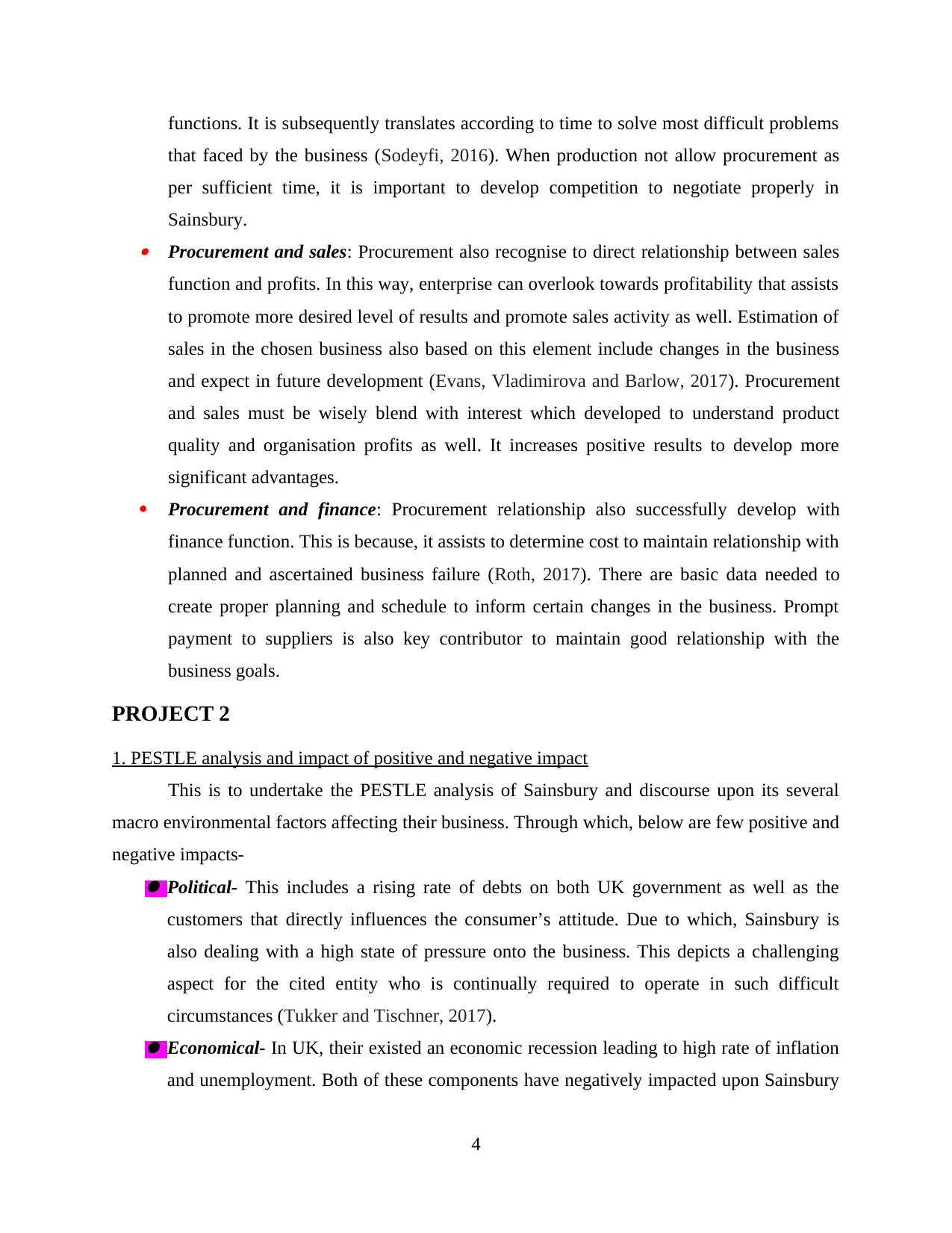
functions. It is subsequently translates according to time to solve most difficult problems
that faced by the business (Sodeyfi, 2016). When production not allow procurement as
per sufficient time, it is important to develop competition to negotiate properly in
Sainsbury. Procurement and sales: Procurement also recognise to direct relationship between sales
function and profits. In this way, enterprise can overlook towards profitability that assists
to promote more desired level of results and promote sales activity as well. Estimation of
sales in the chosen business also based on this element include changes in the business
and expect in future development (Evans, Vladimirova and Barlow, 2017). Procurement
and sales must be wisely blend with interest which developed to understand product
quality and organisation profits as well. It increases positive results to develop more
significant advantages.
Procurement and finance: Procurement relationship also successfully develop with
finance function. This is because, it assists to determine cost to maintain relationship with
planned and ascertained business failure (Roth, 2017). There are basic data needed to
create proper planning and schedule to inform certain changes in the business. Prompt
payment to suppliers is also key contributor to maintain good relationship with the
business goals.
PROJECT 2
1. PESTLE analysis and impact of positive and negative impact
This is to undertake the PESTLE analysis of Sainsbury and discourse upon its several
macro environmental factors affecting their business. Through which, below are few positive and
negative impacts- Political- This includes a rising rate of debts on both UK government as well as the
customers that directly influences the consumer’s attitude. Due to which, Sainsbury is
also dealing with a high state of pressure onto the business. This depicts a challenging
aspect for the cited entity who is continually required to operate in such difficult
circumstances (Tukker and Tischner, 2017). Economical- In UK, their existed an economic recession leading to high rate of inflation
and unemployment. Both of these components have negatively impacted upon Sainsbury
4
that faced by the business (Sodeyfi, 2016). When production not allow procurement as
per sufficient time, it is important to develop competition to negotiate properly in
Sainsbury. Procurement and sales: Procurement also recognise to direct relationship between sales
function and profits. In this way, enterprise can overlook towards profitability that assists
to promote more desired level of results and promote sales activity as well. Estimation of
sales in the chosen business also based on this element include changes in the business
and expect in future development (Evans, Vladimirova and Barlow, 2017). Procurement
and sales must be wisely blend with interest which developed to understand product
quality and organisation profits as well. It increases positive results to develop more
significant advantages.
Procurement and finance: Procurement relationship also successfully develop with
finance function. This is because, it assists to determine cost to maintain relationship with
planned and ascertained business failure (Roth, 2017). There are basic data needed to
create proper planning and schedule to inform certain changes in the business. Prompt
payment to suppliers is also key contributor to maintain good relationship with the
business goals.
PROJECT 2
1. PESTLE analysis and impact of positive and negative impact
This is to undertake the PESTLE analysis of Sainsbury and discourse upon its several
macro environmental factors affecting their business. Through which, below are few positive and
negative impacts- Political- This includes a rising rate of debts on both UK government as well as the
customers that directly influences the consumer’s attitude. Due to which, Sainsbury is
also dealing with a high state of pressure onto the business. This depicts a challenging
aspect for the cited entity who is continually required to operate in such difficult
circumstances (Tukker and Tischner, 2017). Economical- In UK, their existed an economic recession leading to high rate of inflation
and unemployment. Both of these components have negatively impacted upon Sainsbury
4
Paraphrase This Document
Need a fresh take? Get an instant paraphrase of this document with our AI Paraphraser
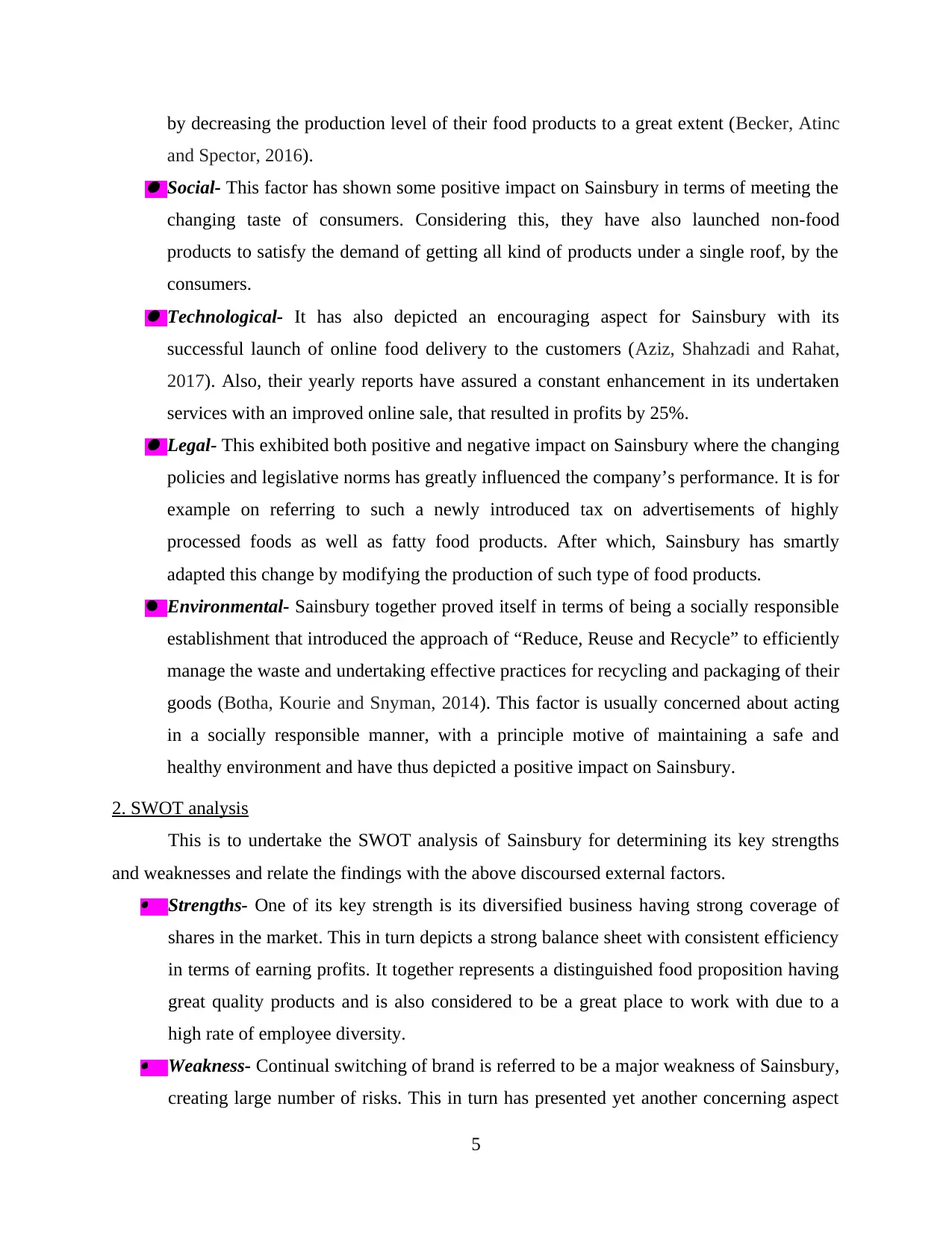
by decreasing the production level of their food products to a great extent (Becker, Atinc
and Spector, 2016). Social- This factor has shown some positive impact on Sainsbury in terms of meeting the
changing taste of consumers. Considering this, they have also launched non-food
products to satisfy the demand of getting all kind of products under a single roof, by the
consumers. Technological- It has also depicted an encouraging aspect for Sainsbury with its
successful launch of online food delivery to the customers (Aziz, Shahzadi and Rahat,
2017). Also, their yearly reports have assured a constant enhancement in its undertaken
services with an improved online sale, that resulted in profits by 25%. Legal- This exhibited both positive and negative impact on Sainsbury where the changing
policies and legislative norms has greatly influenced the company’s performance. It is for
example on referring to such a newly introduced tax on advertisements of highly
processed foods as well as fatty food products. After which, Sainsbury has smartly
adapted this change by modifying the production of such type of food products.
Environmental- Sainsbury together proved itself in terms of being a socially responsible
establishment that introduced the approach of “Reduce, Reuse and Recycle” to efficiently
manage the waste and undertaking effective practices for recycling and packaging of their
goods (Botha, Kourie and Snyman, 2014). This factor is usually concerned about acting
in a socially responsible manner, with a principle motive of maintaining a safe and
healthy environment and have thus depicted a positive impact on Sainsbury.
2. SWOT analysis
This is to undertake the SWOT analysis of Sainsbury for determining its key strengths
and weaknesses and relate the findings with the above discoursed external factors. Strengths- One of its key strength is its diversified business having strong coverage of
shares in the market. This in turn depicts a strong balance sheet with consistent efficiency
in terms of earning profits. It together represents a distinguished food proposition having
great quality products and is also considered to be a great place to work with due to a
high rate of employee diversity. Weakness- Continual switching of brand is referred to be a major weakness of Sainsbury,
creating large number of risks. This in turn has presented yet another concerning aspect
5
and Spector, 2016). Social- This factor has shown some positive impact on Sainsbury in terms of meeting the
changing taste of consumers. Considering this, they have also launched non-food
products to satisfy the demand of getting all kind of products under a single roof, by the
consumers. Technological- It has also depicted an encouraging aspect for Sainsbury with its
successful launch of online food delivery to the customers (Aziz, Shahzadi and Rahat,
2017). Also, their yearly reports have assured a constant enhancement in its undertaken
services with an improved online sale, that resulted in profits by 25%. Legal- This exhibited both positive and negative impact on Sainsbury where the changing
policies and legislative norms has greatly influenced the company’s performance. It is for
example on referring to such a newly introduced tax on advertisements of highly
processed foods as well as fatty food products. After which, Sainsbury has smartly
adapted this change by modifying the production of such type of food products.
Environmental- Sainsbury together proved itself in terms of being a socially responsible
establishment that introduced the approach of “Reduce, Reuse and Recycle” to efficiently
manage the waste and undertaking effective practices for recycling and packaging of their
goods (Botha, Kourie and Snyman, 2014). This factor is usually concerned about acting
in a socially responsible manner, with a principle motive of maintaining a safe and
healthy environment and have thus depicted a positive impact on Sainsbury.
2. SWOT analysis
This is to undertake the SWOT analysis of Sainsbury for determining its key strengths
and weaknesses and relate the findings with the above discoursed external factors. Strengths- One of its key strength is its diversified business having strong coverage of
shares in the market. This in turn depicts a strong balance sheet with consistent efficiency
in terms of earning profits. It together represents a distinguished food proposition having
great quality products and is also considered to be a great place to work with due to a
high rate of employee diversity. Weakness- Continual switching of brand is referred to be a major weakness of Sainsbury,
creating large number of risks. This in turn has presented yet another concerning aspect
5
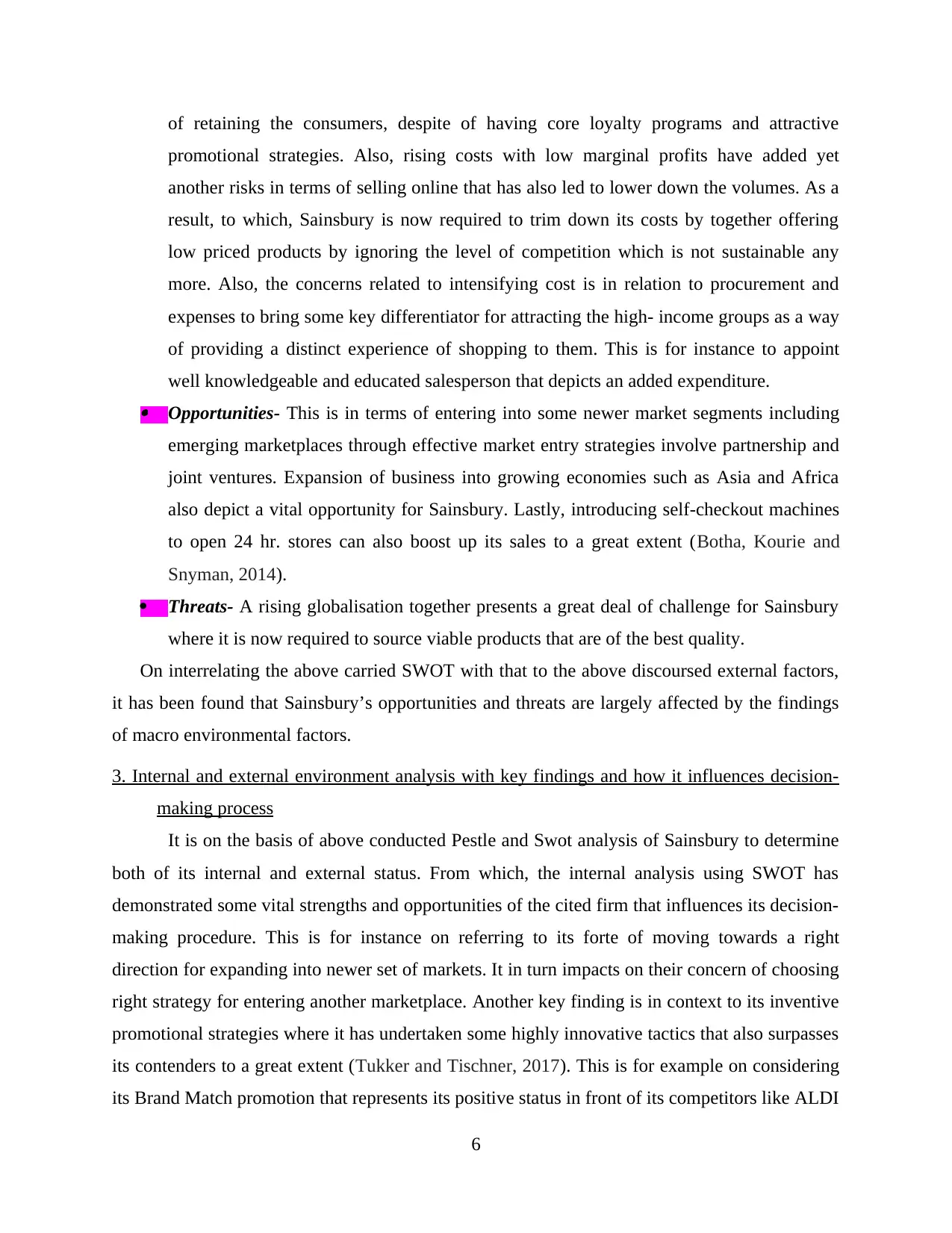
of retaining the consumers, despite of having core loyalty programs and attractive
promotional strategies. Also, rising costs with low marginal profits have added yet
another risks in terms of selling online that has also led to lower down the volumes. As a
result, to which, Sainsbury is now required to trim down its costs by together offering
low priced products by ignoring the level of competition which is not sustainable any
more. Also, the concerns related to intensifying cost is in relation to procurement and
expenses to bring some key differentiator for attracting the high- income groups as a way
of providing a distinct experience of shopping to them. This is for instance to appoint
well knowledgeable and educated salesperson that depicts an added expenditure. Opportunities- This is in terms of entering into some newer market segments including
emerging marketplaces through effective market entry strategies involve partnership and
joint ventures. Expansion of business into growing economies such as Asia and Africa
also depict a vital opportunity for Sainsbury. Lastly, introducing self-checkout machines
to open 24 hr. stores can also boost up its sales to a great extent (Botha, Kourie and
Snyman, 2014).
Threats- A rising globalisation together presents a great deal of challenge for Sainsbury
where it is now required to source viable products that are of the best quality.
On interrelating the above carried SWOT with that to the above discoursed external factors,
it has been found that Sainsbury’s opportunities and threats are largely affected by the findings
of macro environmental factors.
3. Internal and external environment analysis with key findings and how it influences decision-
making process
It is on the basis of above conducted Pestle and Swot analysis of Sainsbury to determine
both of its internal and external status. From which, the internal analysis using SWOT has
demonstrated some vital strengths and opportunities of the cited firm that influences its decision-
making procedure. This is for instance on referring to its forte of moving towards a right
direction for expanding into newer set of markets. It in turn impacts on their concern of choosing
right strategy for entering another marketplace. Another key finding is in context to its inventive
promotional strategies where it has undertaken some highly innovative tactics that also surpasses
its contenders to a great extent (Tukker and Tischner, 2017). This is for example on considering
its Brand Match promotion that represents its positive status in front of its competitors like ALDI
6
promotional strategies. Also, rising costs with low marginal profits have added yet
another risks in terms of selling online that has also led to lower down the volumes. As a
result, to which, Sainsbury is now required to trim down its costs by together offering
low priced products by ignoring the level of competition which is not sustainable any
more. Also, the concerns related to intensifying cost is in relation to procurement and
expenses to bring some key differentiator for attracting the high- income groups as a way
of providing a distinct experience of shopping to them. This is for instance to appoint
well knowledgeable and educated salesperson that depicts an added expenditure. Opportunities- This is in terms of entering into some newer market segments including
emerging marketplaces through effective market entry strategies involve partnership and
joint ventures. Expansion of business into growing economies such as Asia and Africa
also depict a vital opportunity for Sainsbury. Lastly, introducing self-checkout machines
to open 24 hr. stores can also boost up its sales to a great extent (Botha, Kourie and
Snyman, 2014).
Threats- A rising globalisation together presents a great deal of challenge for Sainsbury
where it is now required to source viable products that are of the best quality.
On interrelating the above carried SWOT with that to the above discoursed external factors,
it has been found that Sainsbury’s opportunities and threats are largely affected by the findings
of macro environmental factors.
3. Internal and external environment analysis with key findings and how it influences decision-
making process
It is on the basis of above conducted Pestle and Swot analysis of Sainsbury to determine
both of its internal and external status. From which, the internal analysis using SWOT has
demonstrated some vital strengths and opportunities of the cited firm that influences its decision-
making procedure. This is for instance on referring to its forte of moving towards a right
direction for expanding into newer set of markets. It in turn impacts on their concern of choosing
right strategy for entering another marketplace. Another key finding is in context to its inventive
promotional strategies where it has undertaken some highly innovative tactics that also surpasses
its contenders to a great extent (Tukker and Tischner, 2017). This is for example on considering
its Brand Match promotion that represents its positive status in front of its competitors like ALDI
6
⊘ This is a preview!⊘
Do you want full access?
Subscribe today to unlock all pages.

Trusted by 1+ million students worldwide
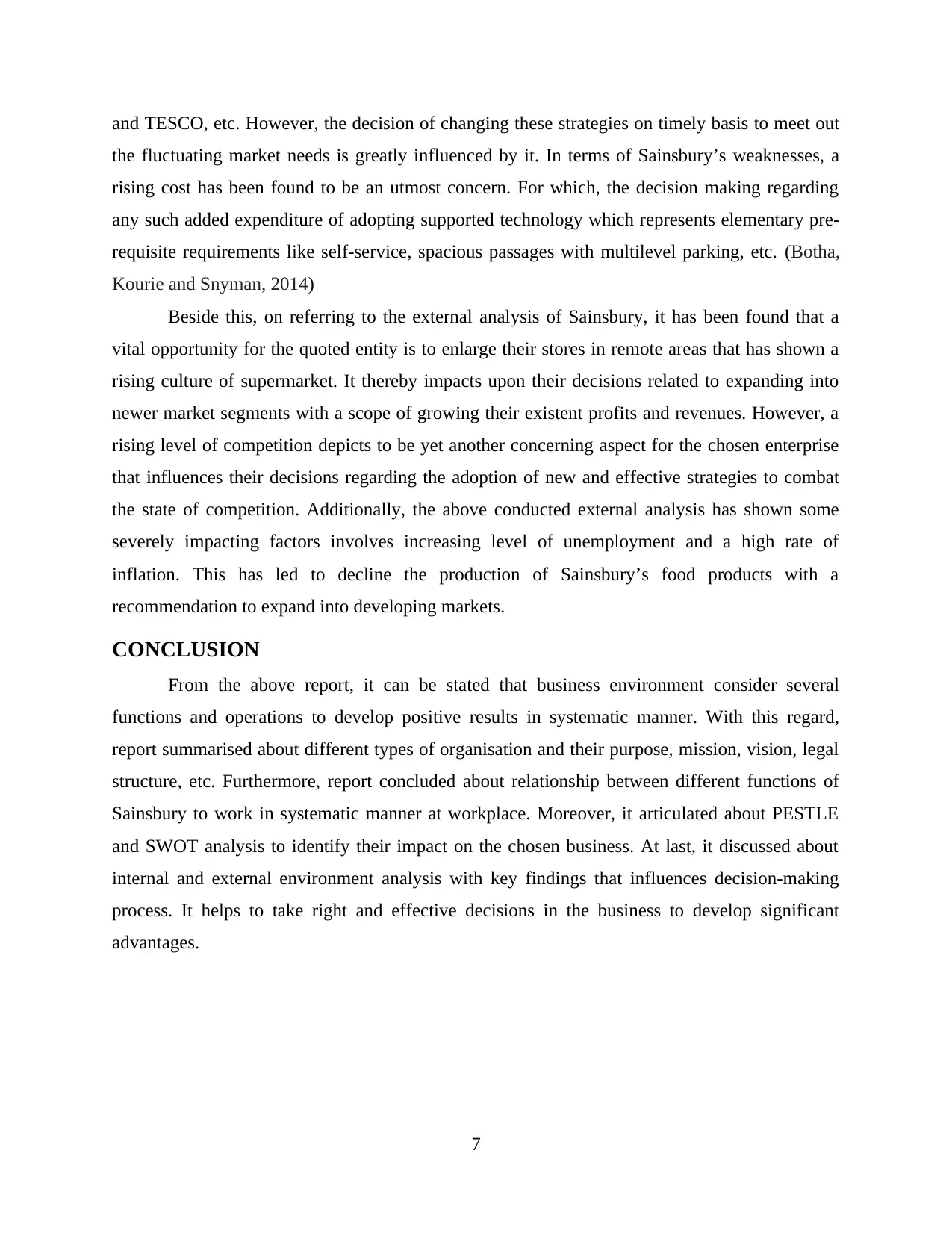
and TESCO, etc. However, the decision of changing these strategies on timely basis to meet out
the fluctuating market needs is greatly influenced by it. In terms of Sainsbury’s weaknesses, a
rising cost has been found to be an utmost concern. For which, the decision making regarding
any such added expenditure of adopting supported technology which represents elementary pre-
requisite requirements like self-service, spacious passages with multilevel parking, etc. (Botha,
Kourie and Snyman, 2014)
Beside this, on referring to the external analysis of Sainsbury, it has been found that a
vital opportunity for the quoted entity is to enlarge their stores in remote areas that has shown a
rising culture of supermarket. It thereby impacts upon their decisions related to expanding into
newer market segments with a scope of growing their existent profits and revenues. However, a
rising level of competition depicts to be yet another concerning aspect for the chosen enterprise
that influences their decisions regarding the adoption of new and effective strategies to combat
the state of competition. Additionally, the above conducted external analysis has shown some
severely impacting factors involves increasing level of unemployment and a high rate of
inflation. This has led to decline the production of Sainsbury’s food products with a
recommendation to expand into developing markets.
CONCLUSION
From the above report, it can be stated that business environment consider several
functions and operations to develop positive results in systematic manner. With this regard,
report summarised about different types of organisation and their purpose, mission, vision, legal
structure, etc. Furthermore, report concluded about relationship between different functions of
Sainsbury to work in systematic manner at workplace. Moreover, it articulated about PESTLE
and SWOT analysis to identify their impact on the chosen business. At last, it discussed about
internal and external environment analysis with key findings that influences decision-making
process. It helps to take right and effective decisions in the business to develop significant
advantages.
7
the fluctuating market needs is greatly influenced by it. In terms of Sainsbury’s weaknesses, a
rising cost has been found to be an utmost concern. For which, the decision making regarding
any such added expenditure of adopting supported technology which represents elementary pre-
requisite requirements like self-service, spacious passages with multilevel parking, etc. (Botha,
Kourie and Snyman, 2014)
Beside this, on referring to the external analysis of Sainsbury, it has been found that a
vital opportunity for the quoted entity is to enlarge their stores in remote areas that has shown a
rising culture of supermarket. It thereby impacts upon their decisions related to expanding into
newer market segments with a scope of growing their existent profits and revenues. However, a
rising level of competition depicts to be yet another concerning aspect for the chosen enterprise
that influences their decisions regarding the adoption of new and effective strategies to combat
the state of competition. Additionally, the above conducted external analysis has shown some
severely impacting factors involves increasing level of unemployment and a high rate of
inflation. This has led to decline the production of Sainsbury’s food products with a
recommendation to expand into developing markets.
CONCLUSION
From the above report, it can be stated that business environment consider several
functions and operations to develop positive results in systematic manner. With this regard,
report summarised about different types of organisation and their purpose, mission, vision, legal
structure, etc. Furthermore, report concluded about relationship between different functions of
Sainsbury to work in systematic manner at workplace. Moreover, it articulated about PESTLE
and SWOT analysis to identify their impact on the chosen business. At last, it discussed about
internal and external environment analysis with key findings that influences decision-making
process. It helps to take right and effective decisions in the business to develop significant
advantages.
7
Paraphrase This Document
Need a fresh take? Get an instant paraphrase of this document with our AI Paraphraser
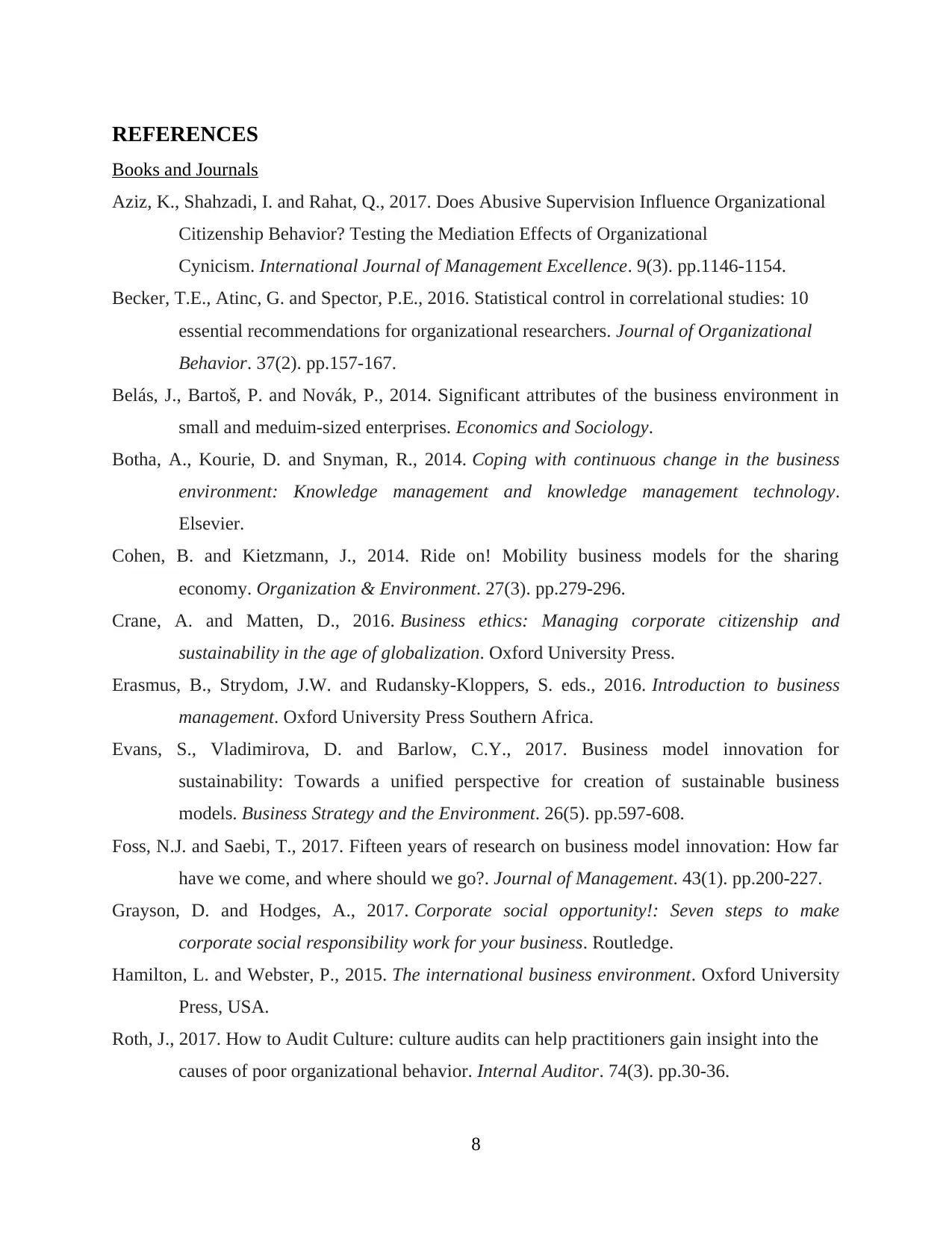
REFERENCES
Books and Journals
Aziz, K., Shahzadi, I. and Rahat, Q., 2017. Does Abusive Supervision Influence Organizational
Citizenship Behavior? Testing the Mediation Effects of Organizational
Cynicism. International Journal of Management Excellence. 9(3). pp.1146-1154.
Becker, T.E., Atinc, G. and Spector, P.E., 2016. Statistical control in correlational studies: 10
essential recommendations for organizational researchers. Journal of Organizational
Behavior. 37(2). pp.157-167.
Belás, J., Bartoš, P. and Novák, P., 2014. Significant attributes of the business environment in
small and meduim-sized enterprises. Economics and Sociology.
Botha, A., Kourie, D. and Snyman, R., 2014. Coping with continuous change in the business
environment: Knowledge management and knowledge management technology.
Elsevier.
Cohen, B. and Kietzmann, J., 2014. Ride on! Mobility business models for the sharing
economy. Organization & Environment. 27(3). pp.279-296.
Crane, A. and Matten, D., 2016. Business ethics: Managing corporate citizenship and
sustainability in the age of globalization. Oxford University Press.
Erasmus, B., Strydom, J.W. and Rudansky-Kloppers, S. eds., 2016. Introduction to business
management. Oxford University Press Southern Africa.
Evans, S., Vladimirova, D. and Barlow, C.Y., 2017. Business model innovation for
sustainability: Towards a unified perspective for creation of sustainable business
models. Business Strategy and the Environment. 26(5). pp.597-608.
Foss, N.J. and Saebi, T., 2017. Fifteen years of research on business model innovation: How far
have we come, and where should we go?. Journal of Management. 43(1). pp.200-227.
Grayson, D. and Hodges, A., 2017. Corporate social opportunity!: Seven steps to make
corporate social responsibility work for your business. Routledge.
Hamilton, L. and Webster, P., 2015. The international business environment. Oxford University
Press, USA.
Roth, J., 2017. How to Audit Culture: culture audits can help practitioners gain insight into the
causes of poor organizational behavior. Internal Auditor. 74(3). pp.30-36.
8
Books and Journals
Aziz, K., Shahzadi, I. and Rahat, Q., 2017. Does Abusive Supervision Influence Organizational
Citizenship Behavior? Testing the Mediation Effects of Organizational
Cynicism. International Journal of Management Excellence. 9(3). pp.1146-1154.
Becker, T.E., Atinc, G. and Spector, P.E., 2016. Statistical control in correlational studies: 10
essential recommendations for organizational researchers. Journal of Organizational
Behavior. 37(2). pp.157-167.
Belás, J., Bartoš, P. and Novák, P., 2014. Significant attributes of the business environment in
small and meduim-sized enterprises. Economics and Sociology.
Botha, A., Kourie, D. and Snyman, R., 2014. Coping with continuous change in the business
environment: Knowledge management and knowledge management technology.
Elsevier.
Cohen, B. and Kietzmann, J., 2014. Ride on! Mobility business models for the sharing
economy. Organization & Environment. 27(3). pp.279-296.
Crane, A. and Matten, D., 2016. Business ethics: Managing corporate citizenship and
sustainability in the age of globalization. Oxford University Press.
Erasmus, B., Strydom, J.W. and Rudansky-Kloppers, S. eds., 2016. Introduction to business
management. Oxford University Press Southern Africa.
Evans, S., Vladimirova, D. and Barlow, C.Y., 2017. Business model innovation for
sustainability: Towards a unified perspective for creation of sustainable business
models. Business Strategy and the Environment. 26(5). pp.597-608.
Foss, N.J. and Saebi, T., 2017. Fifteen years of research on business model innovation: How far
have we come, and where should we go?. Journal of Management. 43(1). pp.200-227.
Grayson, D. and Hodges, A., 2017. Corporate social opportunity!: Seven steps to make
corporate social responsibility work for your business. Routledge.
Hamilton, L. and Webster, P., 2015. The international business environment. Oxford University
Press, USA.
Roth, J., 2017. How to Audit Culture: culture audits can help practitioners gain insight into the
causes of poor organizational behavior. Internal Auditor. 74(3). pp.30-36.
8
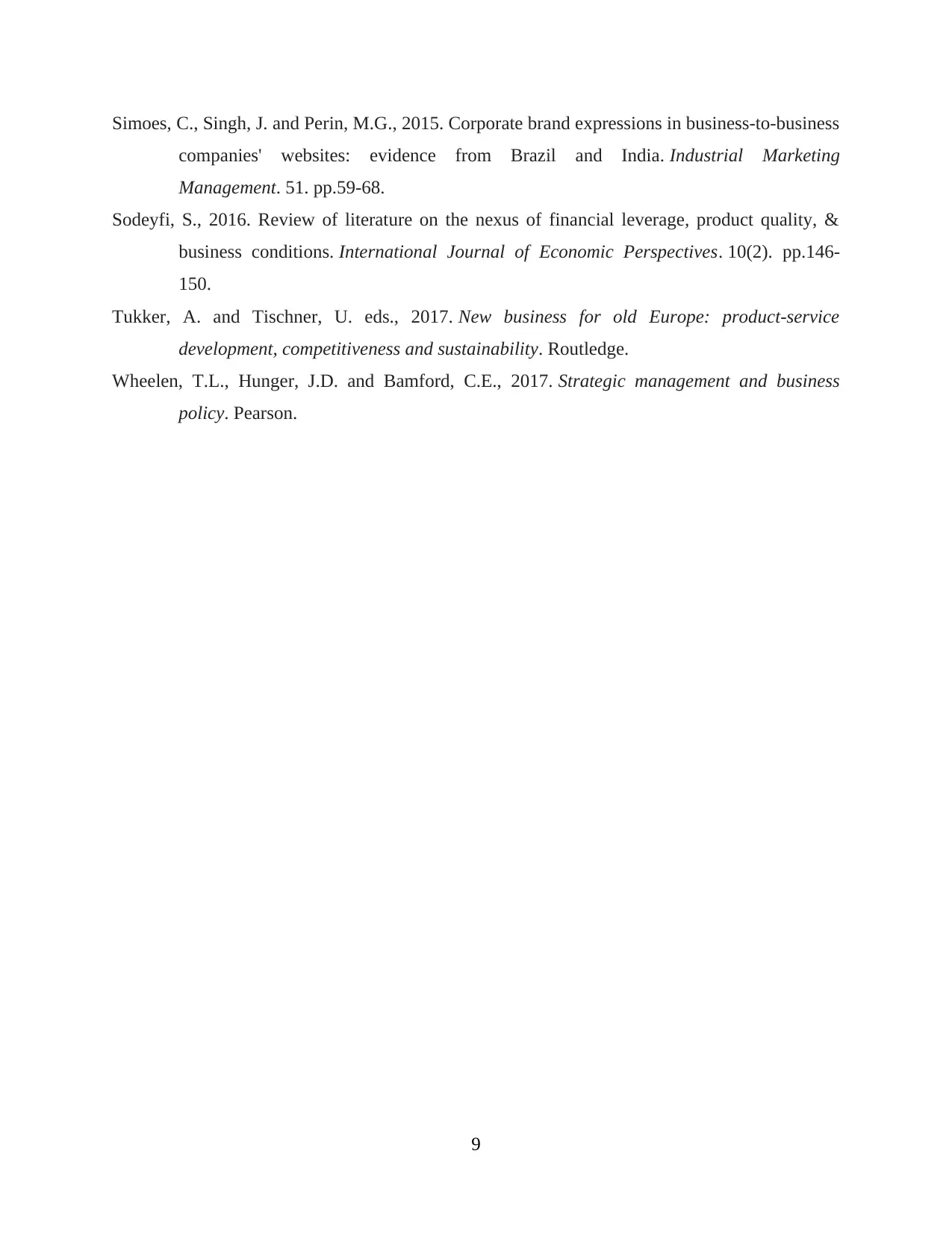
Simoes, C., Singh, J. and Perin, M.G., 2015. Corporate brand expressions in business-to-business
companies' websites: evidence from Brazil and India. Industrial Marketing
Management. 51. pp.59-68.
Sodeyfi, S., 2016. Review of literature on the nexus of financial leverage, product quality, &
business conditions. International Journal of Economic Perspectives. 10(2). pp.146-
150.
Tukker, A. and Tischner, U. eds., 2017. New business for old Europe: product-service
development, competitiveness and sustainability. Routledge.
Wheelen, T.L., Hunger, J.D. and Bamford, C.E., 2017. Strategic management and business
policy. Pearson.
9
companies' websites: evidence from Brazil and India. Industrial Marketing
Management. 51. pp.59-68.
Sodeyfi, S., 2016. Review of literature on the nexus of financial leverage, product quality, &
business conditions. International Journal of Economic Perspectives. 10(2). pp.146-
150.
Tukker, A. and Tischner, U. eds., 2017. New business for old Europe: product-service
development, competitiveness and sustainability. Routledge.
Wheelen, T.L., Hunger, J.D. and Bamford, C.E., 2017. Strategic management and business
policy. Pearson.
9
⊘ This is a preview!⊘
Do you want full access?
Subscribe today to unlock all pages.

Trusted by 1+ million students worldwide
1 out of 12
Related Documents
Your All-in-One AI-Powered Toolkit for Academic Success.
+13062052269
info@desklib.com
Available 24*7 on WhatsApp / Email
![[object Object]](/_next/static/media/star-bottom.7253800d.svg)
Unlock your academic potential
Copyright © 2020–2025 A2Z Services. All Rights Reserved. Developed and managed by ZUCOL.




